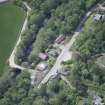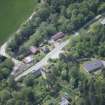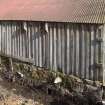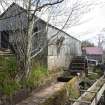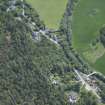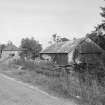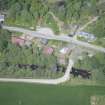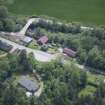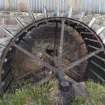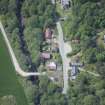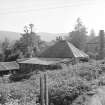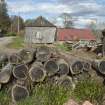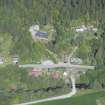Scheduled Maintenance
Please be advised that this website will undergo scheduled maintenance on the following dates: •
Tuesday 3rd December 11:00-15:00
During these times, some services may be temporarily unavailable. We apologise for any inconvenience this may cause.
Finzean, Water Powered Woodworking Complex
Saw Mill (19th Century), Wood Processing Site (19th Century)
Site Name Finzean, Water Powered Woodworking Complex
Classification Saw Mill (19th Century), Wood Processing Site (19th Century)
Alternative Name(s) Finzean House Estate; Forest Of Birse; Water Of Feugh
Canmore ID 120084
Site Number NO59SE 22
NGR NO 59119 91586
Datum OSGB36 - NGR
Permalink http://canmore.org.uk/site/120084
- Council Aberdeenshire
- Parish Birse
- Former Region Grampian
- Former District Kincardine And Deeside
- Former County Aberdeenshire
NO59SE 22 59119 91586
Finzean Sawmill [NAT]
OS 1:10,000 map, 1982.
NO59SE 9 57760 91208 Bucket Mill
NO59SE 14.00 59155 93415 Finzean House
NO69SW 19.01 61170 92012 Mill of Clinter
(Location cited as NO 591 916 and name as Turning works, Forest of Birse). Late 19th cent. A group of single-storey wooden buildings with two low-breat wood-and-iron paddlewheels, and the site for a third. The lower of the two has six spokes and is 3 ft 6 ins (1.06m) wide by 10 ft (3.05m) in diameter; the upper is 16 ft (4.88m) in diameter. A remarkable working complex.
J R Hume 1977.
See also:
NO59SE 22.1 Finzean, Wood Turning Mill
NO59SE 22.2 Finzean, Sawmill
NO59SE 22.3 Finzean, Kiln
NO59SE 22.4 Finzean, Smithy
NO59SE 22.5 Finzean, Sawmill and Turning Mill, Lade
NO59SE 22.6 Finzean, Garage
NO59SE 22.7 Finzean, Byre
NO59SE 22.8 Finzean, Storehouse
NO59SE 22.9 Finzean, Electricity Sub Station
NO59SE 22.10 Finzean, Weir
NO59SE 22.11 Finzean, Store
Information from HES, Heritage Directorate, Heritage Research Service (Miriam McDonald), 28 September 2023.
Single storey, square-plan former Bus Garage, on stilts to S. 2 2-leaf doors to N elevation; window to centre of W and S elevations; polythene covered window opening to E elevation. Grey slate pyramidal roof with skylights and tiled ridges.
The Finzean Sawmill and Turning Mill, on the N bank of the River Feugh, is a remarkable survival in full working order. The sawmill, and the site of the Bucket Mill were established in the early 19th century to exploit the Glen Ferrick pine woods. From the 1830s to 1871, the sawmill was occupied by a range of different timber contractors who were harvesting timber on Finzean Estate. During this period the sawmiller was Charles Young. In 1871 the operation of the Sawmill passed to Alexander Duncan, who had built the Finzean Turning Mill in the 1830s on the outflow from the sawmill. The Sawmill and Turning Mill is still operated by a member of the Duncan family. In 1999, the ownership of the mills passed from Finzean Estate to Birse Community Trust. Extensive restoration work has been carried out on the mills using local timber milled at the sawmill. (Historic Scotland)
Square-plan kiln with corrugated steel and boarded timber lean-to additions; formerly wood fired, now steam operated. Door flanked by window to W; cast-iron fire box access to S under corrugated lean-to; timber lean-to Smiddy to E, pulleys, belt-driven metal lathes and bellows for forge still in place (restored 1999); N elevation obscured by hill slope. Flat steel sheeting roof with timber battens. Interior: slatted floor with pipework below. Coped, square-plan red brick stack on granite rubble base to N of Kiln.
The Finzean Sawmill and Turning Mill, on the N bank of the River Feugh, is a remarkable survival in full working order. The sawmill, and the site of the Bucket Mill were established in the early 19th century to exploit the Glen Ferrick pine woods. From the 1830s to 1871, the sawmill was occupied by a range of different timber contractors who were harvesting timber on Finzean Estate. During this period the sawmiller was Charles Young. In 1871 the operation of the Sawmill passed to Alexander Duncan, who had built the Finzean Turning Mill in the 1830s on the outflow from the sawmill. The Sawmill and Turning Mill is still operated by a member of the Duncan family. In 1999, the ownership of the mills passed from Finzean Estate to Birse Community Trust. Extensive restoration work has been carried out on the mills using local timber milled at the sawmill. (Historic Scotland)
Publication Account (2013)
‘A rural idyll of man working in harmony with nature. Building materials are all local, scale is small and personal, the energy is free and sustainable and the hand-made equipment has the sensuous smooth patina of long use’.
Ref: Jane Geddes, Deeside and the Mearns (2001)
A Bucket Mill, NO5780 9130, 1853, started by Peter Brown to make wooden buckets and hexagonal floor blocks on lathes turned by a ‘start and awe’ paddle wheel with a double cast iron frame. Wooden launder and detached drying house. Restored in 1980s and owned by Birse Community Trust
B Piercemuir Saw Mill, NO5910 9165, c.1820, operated since 1850 by the Duncan family.
‘Start and a’ wheels, and the iron frame for another leans against a building on the north side of the road. Lade and retaining wall for this and the next were reconstructed in 1999. Still in use, near.
C Turning mill. More wooden buildings, one with a spectacular lean was a bus garage, used to make birch broom handles and porridge spurtles.
There is a diesel generator as back-up power and for electricity generation, when not produced by water.
M Watson, 2013
Publication Account (21 July 2016)
Finzean community forms the southern part of the Parish of Birse (covering 125 sq. kms, population 850) in Lower Deeside, Aberdeenshire. Finzean occupies the upper catchment of the Water of Feugh which is the main tributary to the River Dee.
It is on the Water of Feugh and in the western portion of Finzean that three Grade A listed water powered wood-working mills are located. These are the Bucket Mill and Finzean Sawmill (owned by the Birse Community Trust) and the Duncan's Turning Mill (on Birse Communtiy Trust land). Each of the mills are unique survivals in Scotland and even more so as a group (within 1.6km of each other).
The woodmills have survived due to the forest heritage of Birse parish. The Birse Community Trust manages three forests in the parish (Forest of Birse Commonty (ancient rights), Slewdrum and Balfour (both BCT ownership)) and follow the tradition of 'common good' forests. The management of these produces wood for processing in the mills.
Birse Community Trust, 2015
Note (September 2017)
Buckets, brooms and two-by-four: an example of heritage and the 'common good'
Buckets, brooms and two-by-four - a local community following the tradition of 'common good' * forests has helped to ensure the continuing survival of three remarkable 19th century water-powered, wood-working sites in Aberdeenshire. Rubbing shoulders with the Water of Feugh (the main tributary to the River Dee), the three Category A listed water mills are situated within 1.6km of each other. These buildings represent not only a rare survival, but now also part of a community strategy of economic action, intending to enhance an already strong sense of place for those living around Finzean.
This unique collection of buildings consists of a wooden bucket-making mill, a wood turning mill and a saw mill, but there is also an elaborate lade system, a generator house, kilns for drying the timber to be processed by the mills, a smithy and a charabanc garage dating from the early 20th century. Water from the River Feugh is sent by means of two lades (one serving the Bucket Mill, the other both the Sawmill and the Turning Mill) to waterwheels which , through gears, wheels and power transmission systems, drive the machinery used to saw, shape and turn the wood into useful objects.
The Bucket Mill and Saw Mill are owned by the Birse Community Trust. The Turning Mill is privately owned, but stands on Birse Community Trust land. The money made from selling the timber from the woods (which are also managed by the Trust), as well as the products of the mills, is ploughed back into the community.
*Common good as opposed to profit-orientation and competition.
Finzean Bucket Mill, Wood Turning Mill and Saw Mill
In 1853, Peter Brown redeveloped an existing mill-site and waterfall for the Bucket Mill, in order to produce buckets and hexagonal floor blocks. It was worked by the Brown family until 1974. Eight years later it was taken-over by Mr Stan Moyes, who set about restoring it before opening it to the public in 1990. Thereafter, the mill passed into the ownership of the Birse Community Trust In 1999.
Throughout the 19th century wooden buckets were widely used. During the Second World War they were in such high demand by the Navy, RAF and others, that the business was treated as a reserved occupation with the miller exempted service. The Bucket Mill is still in working order and contains an impressive drive system, an integrated sawmill and an adjacent kiln and bothy.
The wood is cut into staves and the buckets are formed, pinned together and smoothed using water-powered wood-working tools and then finished by hand. Mr Moyes explains the manufacturing process below:
https://canmore.org.uk/collection/1546283
Duncan's Turning Mill, which dates from the 19th century, is built mostly of wood, but an upper floor was added in the late 1930s. It contains lathes which are turned by overhead transmission and pulley wheels powered by a water wheel that is fed by the same lade system as the Saw Mill (see below). The Turning Mill originally concentrated on making birch broom handles, brush heads, porridge spurtles and wooden pins for golf clubs and herring barrels. Mr David Duncan explains how the broom heads were formed on the lathe in the link below:
https://canmore.org.uk/collection/1545777
The Saw Mill, which is adjacent to the Turning Mill, has been in operation since 1850 and was also owned originally by the Duncan family. Like the Turning Mill and the Bucket Mill, it is constructed mostly of wood, with stone foundation walls and a corrugated iron roof. The power transmission, like that of the Bucket Mill, is situated under the building.
Miriam R McDonald - Industrial Survey, Historic Environment Scotland




























